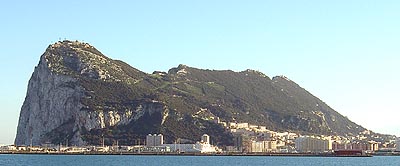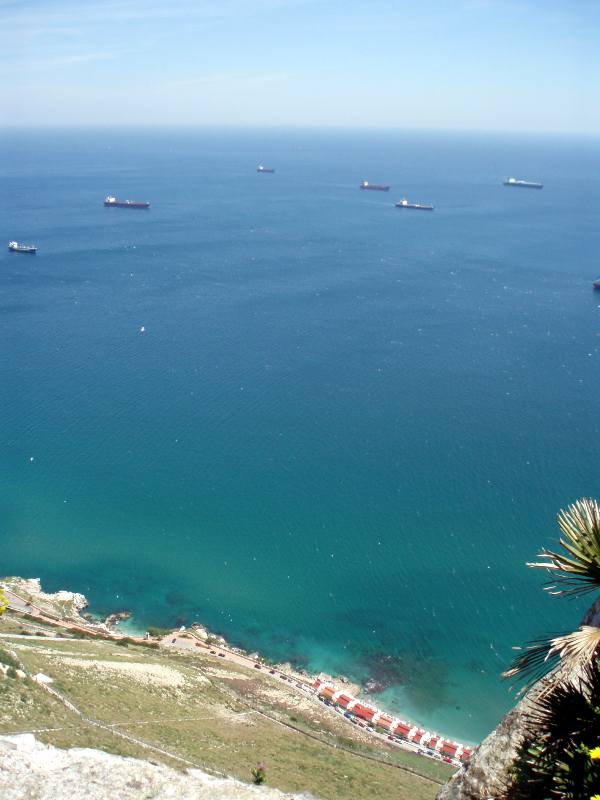Gibraltar ( /dʒɨˈbrɔːltər/) is a British overseas territory located on the southern end of the Iberian Peninsula at the entrance of the Mediterranean. A peninsula with an area of 6.843 square kilometres (2.642 sq mi), it has a northern border with Andalusia, Spain. The Rock of Gibraltar is the major landmark of the region. At its foot is the densely populated city area, home to almost 30,000 Gibraltarians and other nationalities.
View of the northern face of the Moorish Castle's Tower of Homage, Gibraltar's first permanent settlement, built around 711
An Anglo-Dutch force captured Gibraltar in 1704 during the War of the Spanish Succession. The territory was subsequently ceded to Britain by Spain "in perpetuity" under the Treaty of Utrecht in 1713. It was an important base for the British Royal Navy; today its economy is based largely on tourism, financial services, and shipping.
Western, John Mackintosh Square entrance to the Gibraltar Parliament
The sovereignty of Gibraltar is a major point of contention in Anglo-Spanish relations as Spain asserts a claim to the territory.Gibraltarians resoundingly rejected proposals for Spanish sovereignty in a 1967 referendum and again in 2002. Under Gibraltar constitution of 2006, Gibraltar governs its own affairs, though some powers, such as defence and foreign relations, remain the responsibility of the UK Government.
View of the Rock of Gibraltar from Algeciras Bay depicting Westside and the town area
History
Neanderthal habitation in Gibraltar between 128,000 and 24,000 BC has been discovered at Gorham's Cave, making Gibraltar the last known holdout of the Neanderthals. Within recorded history, the first inhabitants were the Phoenicians, around 950 BC. Subsequently, Gibraltar became known as one of the Pillars of Hercules, after the Greek legend of the creation of the Strait of Gibraltar by Heracles. The Carthaginians and Romans also established semi-permanent settlements. After the collapse of the Roman Empire, Gibraltar came briefly under the control of the Vandals. The area later formed part of the Visigothic Kingdom of Hispania until the Islamic conquest of Iberia in 711 AD. Seven centuries of Moorish control ended when Gibraltar was recaptured by the Duke of Medina Sidonia in 1462 as part of the Spanish Reconquista.
After the conquest, King Henry IV assumed the title of King of Gibraltar, establishing it as part of the municipal area of the Campo Llano de Gibraltar.Six years later Gibraltar was restored to the Duke of Medina Sidonia who sold it in 1474 to a group of Jewish conversos from Córdoba and Seville in exchange for maintaining the garrison of the town for two years, after which time the 4,350 Jews were expelled by the Duke as part of the Inquisition.[10] In 1501 Gibraltar passed back to the hands of the Spanish Crown and Isabella I of Castile issued a Royal Warrant granting Gibraltar the coat of arms that it still uses today.
The semi-wild Barbary Macaques form an integral part of Tourism in Gibraltar.
In 1704, during the War of the Spanish Succession, a combined Anglo-Dutch force captured the town of Gibraltar, leading to a permanent exodus of the existing population to the surrounding areas of the Campo de Gibraltar. Under the terms of the 1713 Treaty of Utrecht Gibraltar was ceded to Britain in perpetuity. Spain unsuccessfully attempted to regain control during the Great Siege of Gibraltar which lasted from 1779 to 1783.
The Anglican Cathedral of the Holy Trinity is the larger of the two cathedrals in Gibraltar.
Gibraltar became a key base for the British Royal Navy and played an important role prior to the Battle of Trafalgar and during the Crimean War of 1854–56, due to its strategic location. Its strategic value increased with the opening of the Suez Canal as it lay on the sea route between the UK and the British Empire east of Suez. In the later 19th century there were major investments in improving the fortifications and the port.
The Ibrahim-al-Ibrahim Mosque was a gift by King Fahd of Saudi Arabia.
During World War II, Gibraltar's civilian population was evacuated (mainly to London, England, but also to parts of Morocco, Madeira and Jamaica) and the Rock was strengthened as a fortress. Spanish dictator Francisco Franco's reluctance to allow the German Army onto Spanish soil frustrated a German plan to capture the Rock, codenamed Operation Felix. In the 1950s, Franco renewed Spain's claim to sovereignty over Gibraltar and restricted movement between Gibraltar and Spain. Gibraltarians voted overwhelmingly to remain under British sovereignty in a 1967 referendum which led to the passing of the Gibraltar Constitution Order in 1969. In response, Spain completely closed the border with Gibraltar and severed all communication links. The border with Spain was partially reopened in 1982, and fully reopened in 1985 prior to Spain's accession to the European Community.
Tercentenary celebrations in Gibraltar
In a referendum held in 2002, Gibraltarians rejected by an overwhelming majority (99%) a proposal of shared sovereignty on which Spain and Britain were said to have reached "broad agreement". The British government has committed itself to respecting the Gibraltarians' wishes. A new Constitution Order was approved in referendum in 2006. A process of tripartite negotiations started in 2006 between Spain, Gibraltar and the UK, ending some restrictions and dealing with disputes in some specific areas such as air movements, customs procedures, telecommunications, pensions and cultural exchange
A plaque in City Mill Lane marking the site of Gibraltar's first telephone exchange
Culture
The culture of Gibraltar reflects Gibraltarians' diverse origins. While there are Spanish (mostly from nearby Andalusia) and British influences, the ethnic origins of most Gibraltarians are not confined to these ethnicities. Other ethnicities include Genoese, Maltese, Portuguese, and German. A few other Gibraltar residents are Jewish of Sephardic origin, Moroccan, or Indians. British influence remains strong, with English being the language of government, commerce, education, and the media.
A Victorian Post Box of standard 1887 UK design in use in Gibraltar's Main Street
Gibraltar's first sovereignty referendum is celebrated annually on Gibraltar National Day (10 September). It is a public holiday, during which most Gibraltarians dress in their national colours of red and white and 30,000 similarly coloured balloons are released, to represent the people of Gibraltar. The 300th anniversary of Gibraltar's capture was celebrated in 2004 on Tercentenary Day (4 August), when in recognition of and with thanks for its long association with Gibraltar, the Royal Navy was given the Freedom of the City of Gibraltar and a human chain of Gibraltarians dressed in red, white and blue, linked hands to encircle the Rock.
The Gibraltar Broadcasting Corporation operates a television and radio station on UHF, VHF and medium-wave. The radio service is also Internet-streamed. Special events and the daily news bulletin are streamed in video. The other local radio service is operated by the British Forces Broadcasting Service which also provides a limited cable television network to HM Forces. The largest and most frequently published newspaper is the Gibraltar Chronicle, Gibraltar’s oldest established daily newspaper and the world’s second oldest English language newspaper to have been in print continuously with daily editions six days a week. Panorama is published on weekdays, and 7 Days, The New People, and Gibsport are weekly.
There exists a small amount of literary writings by native Gibraltarians. The first work of fiction was probably Héctor Licudi's 1929 novel Barbarita, written in Spanish.[64] It is a largely autobiographical account of the adventures of a young Gibraltarian man. Throughout the 1940s and 1950s, several anthologies of poetry were published by Leopoldo Sanguinetti, Albert Joseph Patron, and Alberto Pizzarello. The 1960s were largely dominated by the theatrical works of Elio Cruz and his two highly acclaimed Spanish language plays La Lola se va pá Londre and Connie con cama camera en el comedor.[citation needed] In the 1990s, the Gibraltarian man-of-letters Mario Arroyo published Profiles (1994), a series of bilingual meditations on love, loneliness and death. Of late there have been works by the essayist Mary Chiappe such as her volume of essays Cabbages and Kings (2006) and by academic M. G. Sanchez, author of the novel Rock Black 0–10: A Gibraltar fiction (2006).
A number of local bands play original material and covers. Local venues have begun accepting Gibraltarian bands and those from nearby Spain, resulting in a varied mix of live performances every weekend as well as some weekday nights. Musicians from Gibraltar include Charles Ramirez, the first guitarist invited to play with the Royal College of Music Orchestra, successful rock bands like Breed 77, Melon Diesel and Taxi. Albert Hammond, had top 10 hits in the UK and US, and has written many songs for international artists such as Whitney Houston, Tina Turner and Julio Iglesias among many others.
The cuisine of Gibraltar is the result of the rich diversity of civilizations who held the Rock during its history; from the Berbers of North Africa to the Andalusians and British. The culinary influences include those from Malta, Genoa, Portugal and Andalusia. This marriage of tastes has given Gibraltar an eclectic mix of Arabic, Mediterranean and British cuisines. Calentita, a baked bread-like dish made with chickpea flour, water, olive oil, salt and pepper, is considered Gibraltar's national dish.
Gibraltar Monkeys Barbary Macaque
Gibraltar is an independent territory of the United Kingdom, though Spain asserts a claim to the territory and seeks its return. On land, Gibraltar borders on the Spanish town of la Línea de la Concepción from which it is separated by a demilitarized zone where an artificial runway and a border crossing were built.
It is linked to the continent by a sandbar rising a few metres over the sea surface. Broken many times in the pas, the Peninsula turned into an island. On the sandbar, there is an airport being the property of the local airlines, Gibraltar Airways, as well as an army barracks. The airport is especially worthy of note as it possesses an artificial runway 2 kilometres long, penetrating 1 kilometre deep into the Bay of Gibraltar.
An interesting point is the junction of the runway and a road where gates are closed for the take-off and landing of planes.
he fortification on the Rock of Gibraltar was constructed by the Berber chieftain who conquered the place in 711. In 1714 the British took possession of Gibraltar and turned the Rock into a great fortification defending the access to the Mediterranean. This place was of the utmost strategic importance during numerous wars over the next centuries. The fortification was constructed mainly on the basis of the land form features and by using rocks of Gibraltar.
One of the main tourist attractions is a labyrinthine network of tunnels and caves which St. Michael’s Cave, serving as an auditorium due to its natural acoustic properties, is the most prominent of.
One of the main tourist attractions is a labyrinthine network of tunnels and caves which St. Michael’s Cave, serving as an auditorium due to its natural acoustic properties, is the most prominent of.
Strait of Gibraltar
Strait of Gibraltar
Strait of Gibraltar
Strait of Gibraltar
Barbary Macaque
Strait of Gibraltar
Museum of Gibraltar
Museum of Gibraltar
English bus
Barbary Macaque
Gibraltar - Cradle of History
Strait of Gibraltar
British flag
 21:17
21:17
 homesweethome
homesweethome






































 Posted in:
Posted in: 








0 意見:
Post a Comment